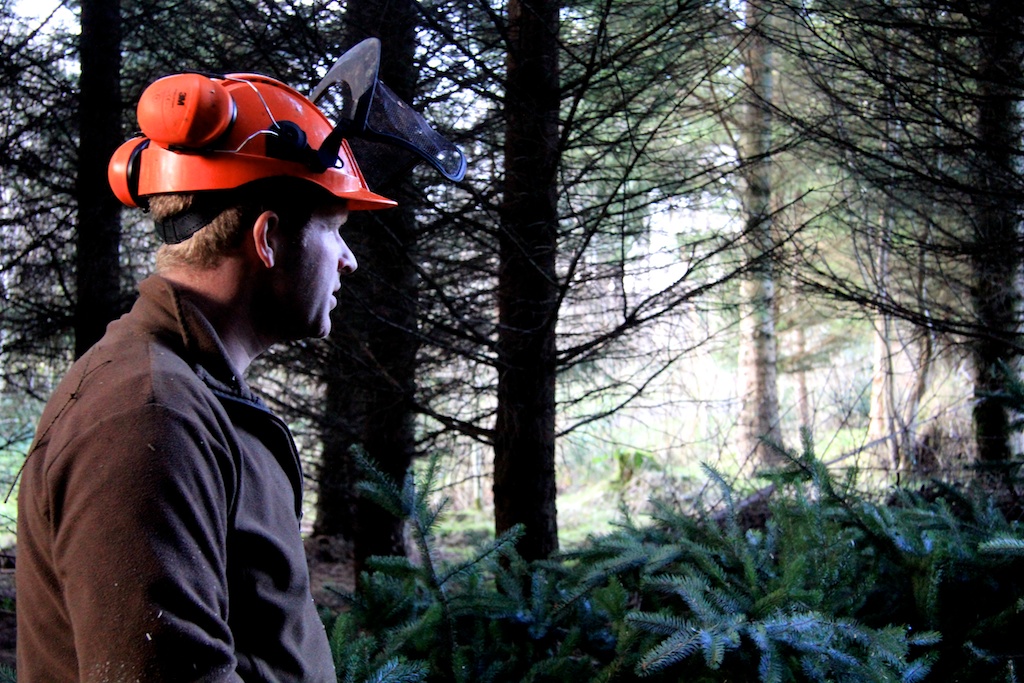You can see our previous marking and tree thinning from 2008-9 here
I’ve been busy last week presenting an update at college (I will share this in my next post) of my long term art & ecology project which is really all about ‘seeing the forest’, to understand a practice of deep sustainability.
However I didn’t realise this week we would be having our forest thinned – its second thinning. Its been overdue and on an off-chance I had rung my forester last week to see if he had any time to do the work in the next month or so. But turned out he had a slot free immediately before a big job and it all happened over the weekend and yesterday. Martin and I ‘marked’ the trees for removal on Sunday and then Sean and Connor felled the trees yesterday. And the weather was perfect.
We are still struggling with the volume of firewood from our first thinning in January 2009 but its all good to have and we do sell some of the firewood to neighbours now. Thinning the forest means that trees are less cramped and therefore less stressed. This is important for their disease resistance and the resilience of the forest as a whole, particularly when thinking about preventative measures against diseases, such as the recent Ash die-back disease. Thinning is also important to help shade intolerant species, such as the naturally regenerating Ash and our planted Sitka spruce that in some areas of our forest had been completely shaded out and outgrown by the Alder (a faster growing pioneer on our site than the Sitka). We removed quite a bit of Alder as you can see in the photos above.
Then I got an email last night to say our small forest is to be inspected this Friday! Crikey, I have our forest, all 2.5 acres of it, listed on the new COFORD (Ireland’s Forest Research organisation) database of plantations that are being transformed into permanent (non clearfell), mixed age, mixed species, forests. This is a new database listing forests around the country that are being managed using Low Impact Sivicultural Systems (LISS). Our wee forest, the smallest listed has been randomly selected and will be visited by some of Ireland’s top foresters this Friday – I will report back.
Any comments very welcome!
Related articles
- practicalities: transformation of a conifer plantation to a forest (ecoartfilm.com)
- Not being able to see the trees for the wood (ecoartfilm.com)
- Permanent forests: with close to nature-continuous cover forestry (ecoartfilm.com)
- Victorian forestry is definitely not ecologically sustainable (theconversation.edu.au)


















Looks great Cathy – well done – might see you on Friday,
Paddy
LikeLike
That’s great Paddy,
just so pleased to have some thinning done beforehand and the weather was great. Some areas probably still need thinning too
LikeLike
sounds (and looks) great Cathy! There was a very dark pine forest beside where I lived growing up – it was very spooky and seemed almost dead inside. One day it was all harvested and I was very annoyed but in no time at all the native trees’ seeds shot up and now it’s a lovely ‘natural’ forest and very colourful in Autumn.
LikeLike
Thanks Candace
Yes blanket plantations of conifers are very dark and not natural or resilient to disease. Glad to hear it was left to recover and regenerate after felling, that’s great. We need so much more progressive thinking for our forests and natural forests have so much to teach us.
LikeLike
Looks great Cathy, well done.
Hopefully see you on Friday!!
Paddy
LikeLike
Best of luck with the inspection Cathy, the forest looks great . Well done on this inspiring project, eoin
LikeLike
Thanks Eoin
and likewise your show up north sounds really impressive.
LikeLike
Hi Cathy, I heard the buzzing this weekend. I think that a visit is just perfect for you, fits right in.
lovely to see the forest develop. annabel
LikeLike
Thanks Annabel
funny how I was discussing how much wood we had last week and now piles more 😉
LikeLike
Looking good Cathy, good luck on Friday!
LikeLike
thanks Nicola
and good luck with your young trees!
LikeLike
Great shots Cath – I loved the one of the cut face especially as it looks like three trees grew into one. Looking at the mass of baby kanuka popping up here I am wondering how forests decide how to thin themselves without human help…..
LikeLike
Ah, nature is very clever…. close to nature forest management is about watching and thinking how things normally work and then applying that knowledge more rapidly and consistently. Storms, fire, rabbits and rodents that think young shoots are better than lettuce all play a part in naturally shaping a forest and that in turn sometimes supports other communities, but you knew that already 😉
LikeLike
Some very good photos! It should look well with the mixture of species in a few years time. What extraction method did you use?
LikeLike
Hi David,
thanks for dropping by. This thinning was relatively light so it involved chainsaws and the wood cut to 3 ft lengths for our gasifier – we are still working towards getting one. When we thinned our forest for the first time in Jan 09 and we removed 25% of the trees as the woodland had never been thinned. Our forester then used the Iron Horse and quads to remove the timber. I think it was the first time it was used in Ireland see more on Iron horse here http://badgershillforestry.ie/
LikeLike
Thanks for the reply. Did you consider using horse extraction as it would be very effective on that size of site?
LikeLike
I know about horse extraction, thanks but none as far as I know in my area. Was lucky to have some Close-to-Nature foresters nearby though
LikeLike
This might be a better format of the same article. Xoxo
LikeLike